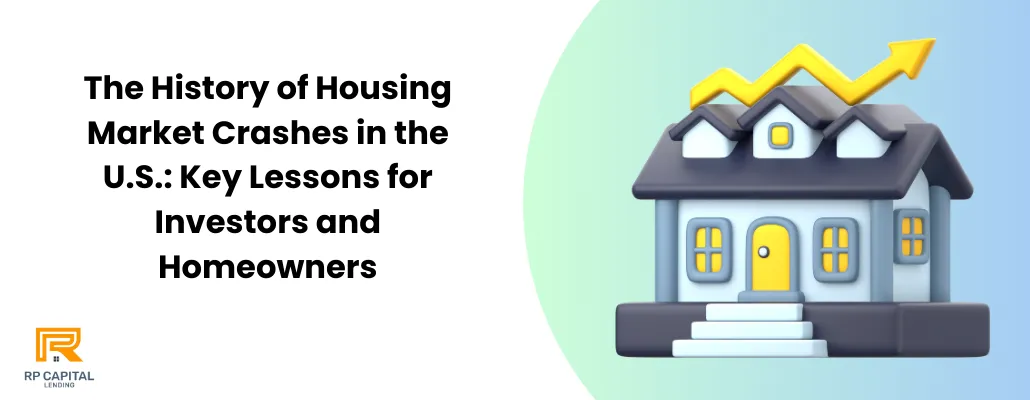Blog

The History of Housing Market Crashes: What They Teach Us About Real Estate
The housing market has always been a key driver of the U.S. economy. When it’s strong, home values rise, creating wealth and stability for millions. But when the market crashes, the impact can be devastating, leading to foreclosures, financial crises, and economic recessions.
Understanding past housing crashes helps investors, homeowners, and policymakers prepare for future downturns. In this article, we will explore some of the most significant housing crashes in U.S. history, their causes, consequences, and what we can learn from them.
What Causes a Housing Market Crash?

Before we dive into history, it's essential to understand the triggers behind a housing market crash. These factors often combine to create a perfect storm:
Speculative Buying: When people purchase homes solely as investments, inflating home prices to unsustainable levels.
Lax Lending Practices: Easy access to credit often leads to risky loans, which become unaffordable during economic downturns.
Interest Rate Changes: Sudden spikes in interest rates can make mortgage payments unaffordable, leading to a spike in defaults.
Economic Recession: A shrinking economy leads to higher unemployment, making it difficult for homeowners to keep up with mortgage payments.
1. The Panic of 1837: America’s First Real Estate Crash
What Happened?
During the early 1830s, the U.S. economy was booming. Land speculation was at an all-time high, and people were borrowing heavily to buy property, expecting prices to keep rising. However, a combination of bad financial policies and economic instability led to a sudden crash.
One major cause was President Andrew Jackson’s Specie Circular, a policy that required land purchases to be made in gold or silver rather than paper money. This created a liquidity crisis, making it difficult for banks and investors to pay off debts.
Effects of the Crash:
Thousands of banks failed due to a lack of hard currency.
Land prices plummeted, leaving many investors bankrupt.
Unemployment skyrocketed, reaching 25% in some areas.
The economy entered a depression that lasted nearly seven years.
Lessons Learned:
Over-reliance on speculative investments without financial backing is risky.
Sudden changes in government policy can have unintended economic consequences.
Having liquid assets and diversified investments is crucial during financial downturns.
2. The Great Depression (1929–1939): The Worst Housing Market Collapse in U.S. History
What Happened?
The 1920s saw a real estate boom, with urban expansion and easy credit fueling housing demand. But in 1929, the stock market crash triggered the Great Depression, leading to widespread economic turmoil.
As banks failed, credit dried up, and people lost jobs, home values plummeted. By 1933, real estate prices in some areas had dropped by over 60%. Home foreclosures became a national crisis, and new home construction nearly stopped.
Effects of the Crash:
Millions of homeowners defaulted on their mortgages.
Home values took nearly 30 years to recover.
The construction industry collapsed, worsening unemployment.
The government responded with the creation of the Federal Housing Administration (FHA) in 1934 to stabilize the market.
Lessons Learned:
A strong financial system is essential for a stable housing market.
Mortgage lending must be carefully regulated to prevent mass defaults.
Government intervention, when done correctly, can help restore confidence in the housing market.
3. The Savings and Loan Crisis (1980s–1990s): The Danger of Deregulation
What Happened?
In the 1980s, the government deregulated the savings and loan (S&L) industry, allowing these institutions to invest in riskier assets, including speculative real estate deals. This led to a housing bubble, as banks and lenders extended risky loans with little oversight.
However, when interest rates spiked in the late 1980s, these financial institutions found themselves in deep trouble. More than 1,000 S&L banks failed, and the government had to step in with a massive bailout.
Effects of the Crash:
Home values dropped significantly in certain regions.
The collapse of S&L institutions cost taxpayers over $132 billion in bailouts.
Stricter financial regulations were introduced to prevent future crises.
Lessons Learned:
Deregulation without oversight can lead to reckless lending.
High-interest rates can significantly impact real estate investments.
Government intervention can help stabilize financial crises, but prevention is better than bailouts.
4. The Subprime Mortgage Crisis (2007–2009): The Most Devastating Modern Crash
What Happened?
The housing bubble of the early 2000s was fueled by subprime mortgages—loans given to borrowers with low credit scores and little financial stability. Banks and lenders encouraged people to take on risky mortgages, often with low teaser rates that later increased dramatically.
As interest rates rose, many homeowners could no longer afford their payments, leading to millions of foreclosures. Housing prices crashed, and the financial sector collapsed, resulting in the Great Recession.
Effects of the Crash:
Home prices fell by nearly 30%, wiping out trillions in household wealth.
Major banks failed, including Lehman Brothers.
The government introduced emergency measures, such as the Troubled Asset Relief Program (TARP), to stabilize the economy.
Lessons Learned:
Homebuyers should only take mortgages they can afford, even if banks offer larger loans.
Real estate bubbles fueled by easy credit will eventually burst.
Stronger regulations on lending practices are necessary to protect homeowners.
5. The COVID-19 Housing Market Disruption (2020–2021): A Unique Crisis
What Happened?
Unlike previous crashes, the COVID-19 pandemic didn’t immediately cause a housing market collapse. Instead, it led to an unexpected boom due to historically low mortgage rates and increased demand for housing. However, economic uncertainty, supply chain disruptions, and rising inflation created concerns about long-term stability.
Effects of the Disruption:
Home prices soared by more than 30% in many areas due to low inventory.
Foreclosure rates initially dropped due to government moratoriums but later increased as policies expired.
Interest rates began rising in 2022, cooling the overheated market.
Lessons Learned:
External factors like pandemics can dramatically impact real estate markets.
Low interest rates can fuel unsustainable price growth.
Investors must prepare for market corrections after rapid increases in home values.
How to Protect Your Investments in the Housing Market
History has shown that housing market crashes can be devastating. However, by understanding the past, homeowners and investors can take steps to safeguard their financial future.
Here are some key takeaways:
Avoid Overleveraging – Don’t take on more debt than you can afford, even if the market looks strong.
Diversify Investments – Don’t put all your money into real estate; balance your portfolio.
Watch for Warning Signs – Rising interest rates, excessive speculation, and easy credit are red flags.
Have a Long-Term Mindset – Real estate is a long-term investment, and markets will have ups and downs.
Stay Informed – Understanding economic trends can help you make smarter decisions.
At RP Capital Lending, we help individuals and businesses make smart real estate investments by providing expert financial guidance. Whether you’re buying, selling, or refinancing, our team is here to support you every step of the way.
Final Thoughts
The U.S. housing market has seen multiple cycles of booms and busts, but with the right knowledge, homeowners and investors can navigate these challenges successfully. By learning from history and applying sound financial strategies, you can build a stronger and more resilient financial future.
Let us know—what are your thoughts on the current housing market? Have you learned any key lessons from past crashes? Drop a comment below!
Read More:
How To Calculate ARV: A Comprehensive Guide
FAQs:
1. What was the worst housing market crash in U.S. history?
The 2008 housing crash is considered the worst, leading to a global financial crisis, millions of foreclosures, and the collapse of several major financial institutions.
2. How did the Great Depression affect the housing market?
The Great Depression caused home prices to drop by 30% and led to widespread foreclosures due to soaring unemployment. Many banks also failed during this time, exacerbating the housing crisis.
3. Why did the 2008 housing bubble burst?
The 2008 bubble burst due to a combination of speculative buying and risky subprime loans. When home prices stopped rising, millions of homeowners were unable to repay their mortgages, leading to mass defaults and foreclosures.
4. Will the housing market crash again?
While it’s impossible to predict with certainty, warning signs like rising mortgage rates, overvalued markets, and lax lending practices could indicate potential risks of another crash in the future.
5. How can I protect myself from a housing market crash?
You can protect yourself by avoiding over-leveraging, investing with a long-term perspective, and keeping cash reserves to navigate economic downturns or capitalize on future opportunities.
RP Capital Lending is a d.b.a of RP Capital Partners Inc (NMLS # 2469193) | Privacy Policy
Copyright © 2022. All Rights Reserved.
Disclaimer: Loans only apply to non-owner occupied properties. Rates, terms and conditions offered only to qualified borrowers, may vary upon loan product, deal structure, other applicable considerations, and are subject to change at any time without notice.

